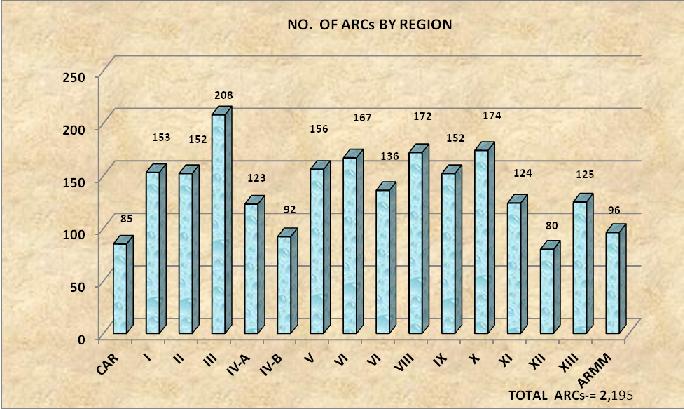ARC Development Strategy
The Agrarian Reform Community (ARC) Development Strategy was adopted in 1993 to focus on priority agrarian reform areas to maximize resource allocation, complementation, and mobilization for greater efficiency and impact taking into consideration the limited financial and material resources of the government.
An ARC is a barangay or cluster of contiguous barangays within a municipality where majority of the CARP-covered lands have been awarded to a critical mass of Agrarian Reform Beneficiaries (ARBs). The ARC strategy applies the integrated area development approach where the ARBs and their communities are the primary focal points of development interventions.
DAR has launched and confirmed 2,195 ARCs as of December 2012 covering 9,635 barangays in 1,362 municipalities and 188 legislative districts. Around 1.44 million ARBs are in the ARCs.

Region III-Central Luzon has the highest number of ARCs (208) followed by Region X – Northern Mindanao.
Palay (irrigated and non-irrigated) is the most predominant crop planted in ARCs (151 ARCs). Coconut is planted in 560 ARCs, while corn and sugarcane are planted in 181 and 115 ARCs, respectively. Pineapple, banana, rubber and other high value crops are considered major crops in some of the ARCs.
The ARCs’ Level of Development Assessment (ALDA) is conducted annually to determine the outcome of the key interventions provided by DAR and its development partners to the ARCs, the ARB organizations and the ARB households. As of 2011, 948 ARCs (48%) were classified under high level of development (level 5); 515 ARCs (26%) were under higher medium level of development (level 4); 297 ARCs (15%) under medium level of development; 146 ARCs (7%) under level 2 or lower medium level; and 77 ARCs or (4%) under low level of development.

The ARC Strategy’s Complementation with Government’s Major Development Programs
DAR has been collaborating with other agencies to mainstream the ARC development in major priority programs of the government. The Social Reform Agenda under the Ramos administration adopted the ARC strategy as its poverty alleviation strategy and made the ARCs as convergence points of government’s resources, services and interventions. Likewise, the KALAHI-Comprehensive and Integrated Delivery of Support Services Program (KALAHI-CIDSS) of DSWD and Strategic Agriculture and Fisheries Development Zones of DA followed suit. The DA-DAR-DENR-DILG National Convergence Initiative (NCI) for Sustainable Rural Development also utilizes the ARC as focal point for complementation. The initiative adopts a convergence framework which promotes sustainable integrated area development by harmonizing the area-based planning units of DA, DAR and DENR to operationalize the sustainable development paradigm in the rural sector through the integration of social, economic and environmental aspects of rural development.
ARC Cluster Development
Evolving from the Bayan-Anihan Agrarian Reform Zones (BARZones) and KALAHI ARZones, the ARC Cluster Development was pursued to enhance ARC connectivity and ARB reach through capacity building, information, learning exchanges and convergence or complementation of development projects and initiatives.
ARC Cluster Development builds on the strength of the ARCs with high level of development which may serve as integrator for ARCs with lower development levels and in complementation with other ARCs and non-ARC barangays within and/or outside the municipalities for an identified common development goal.
